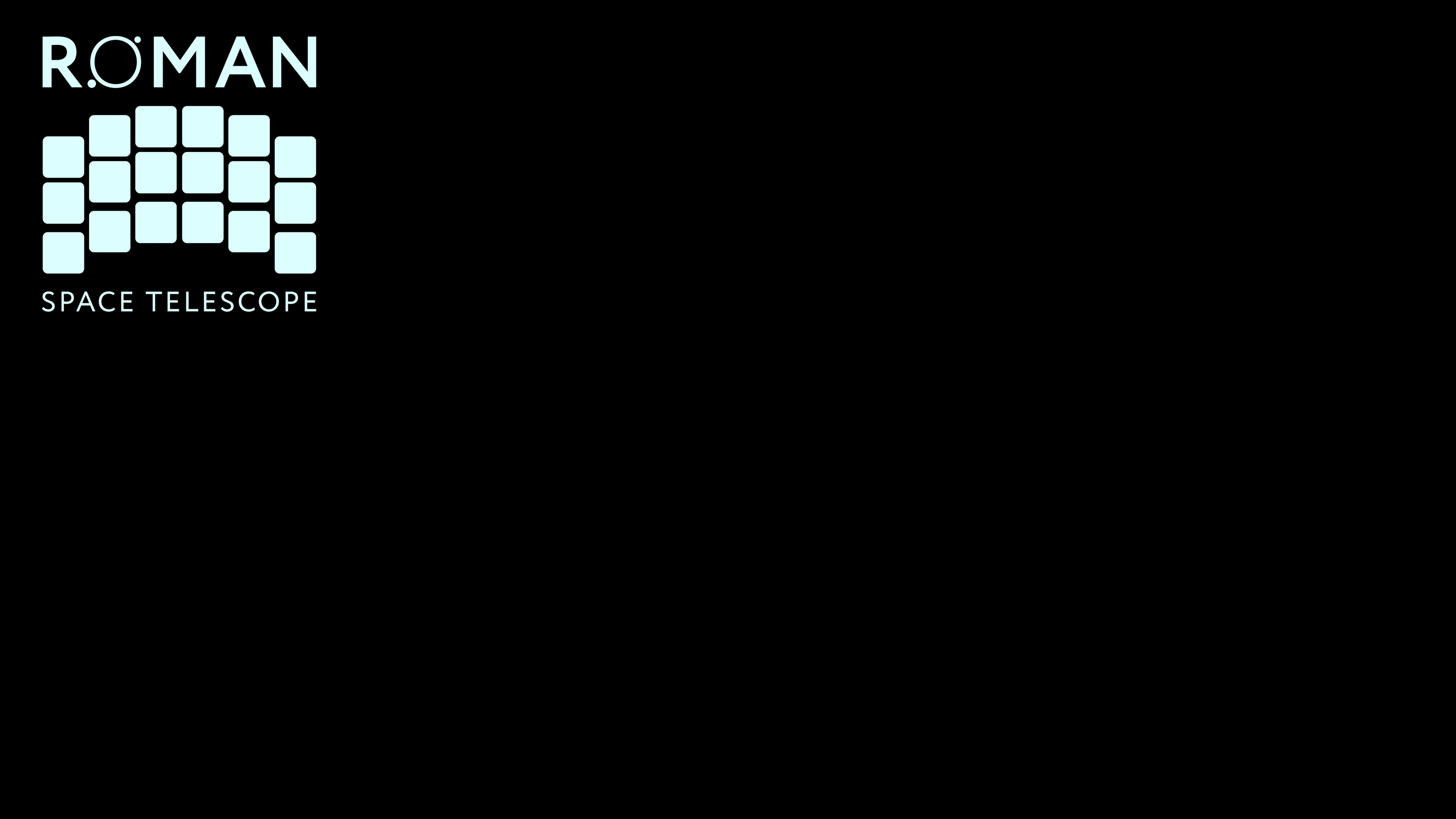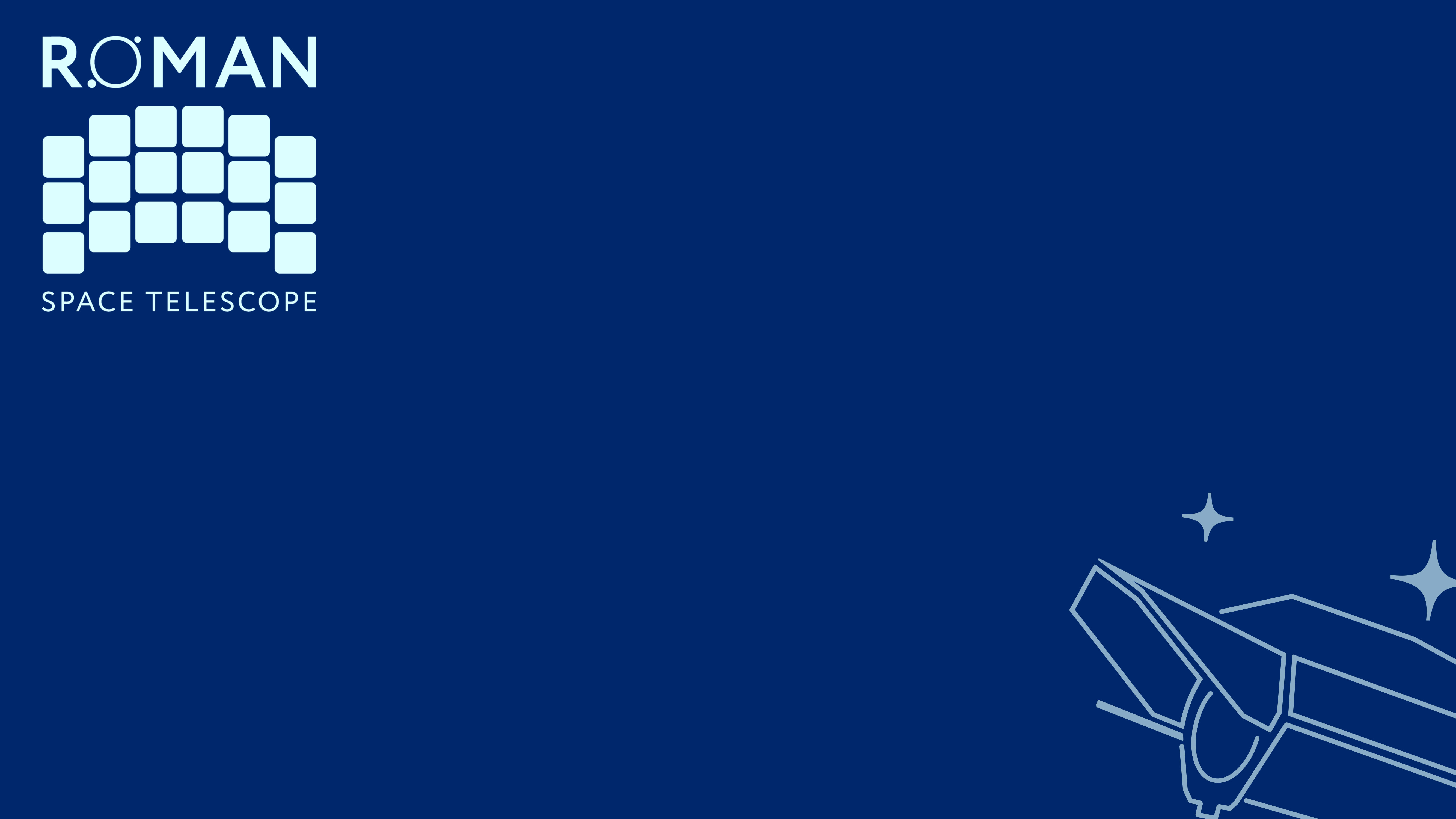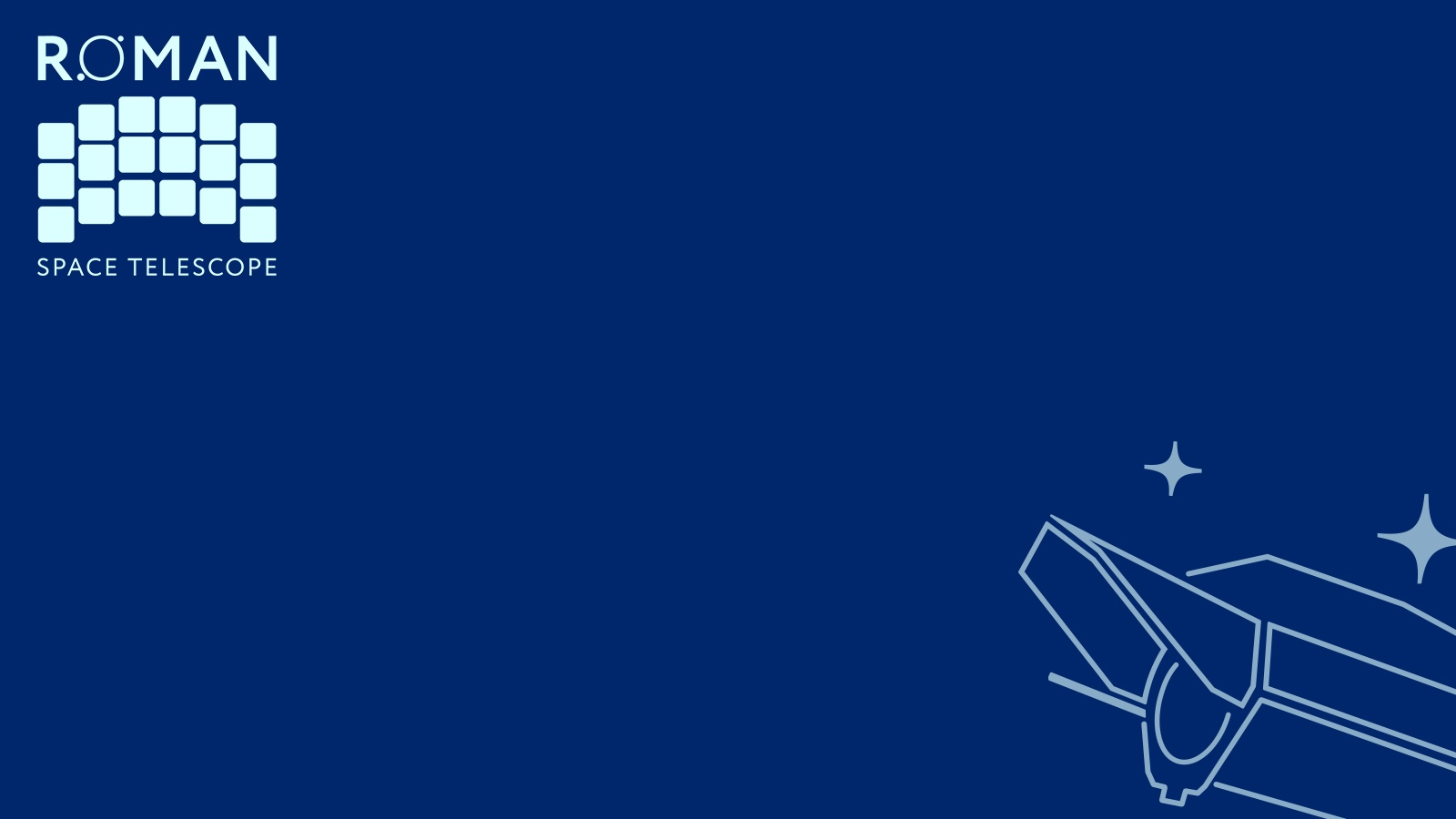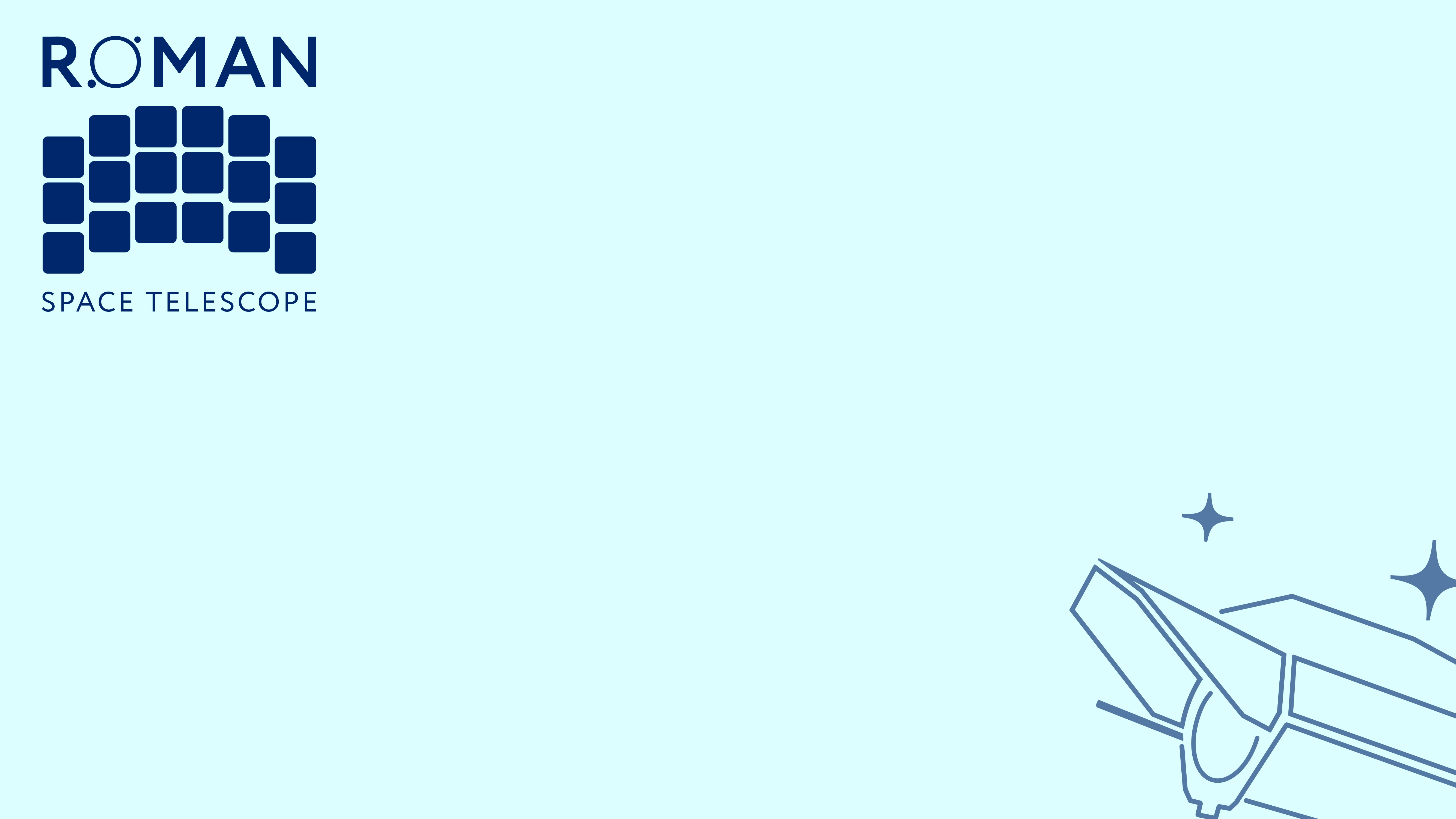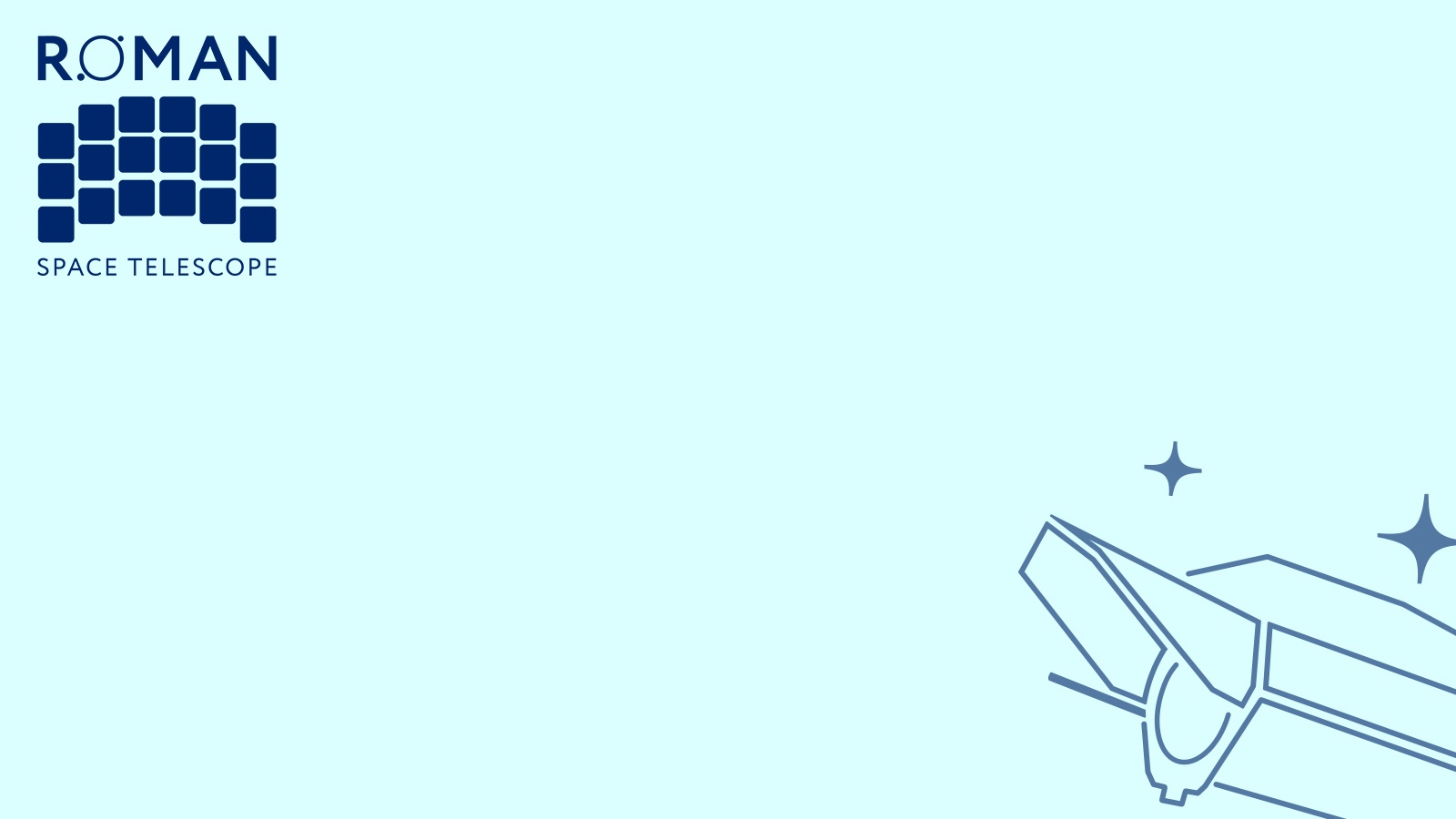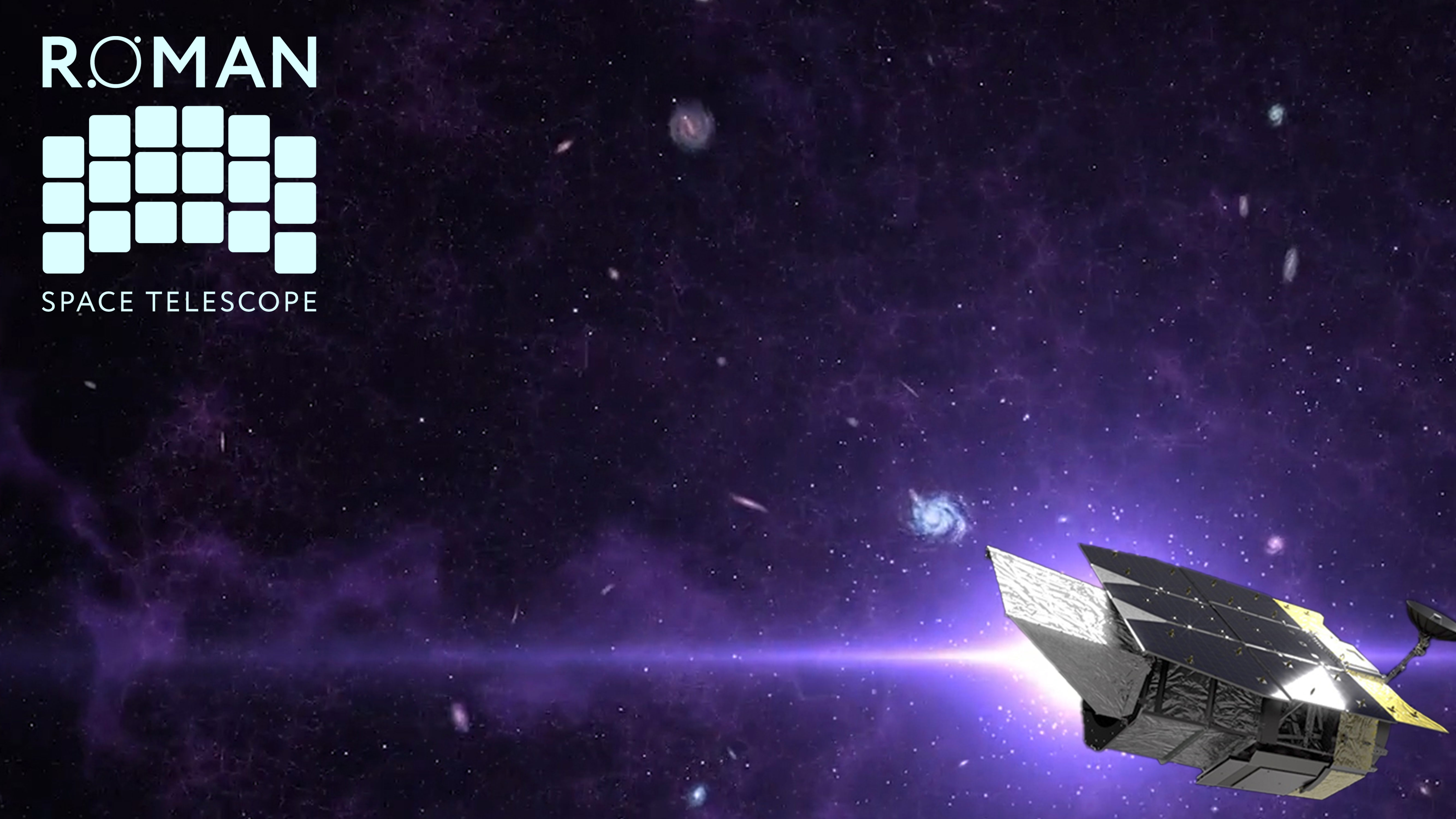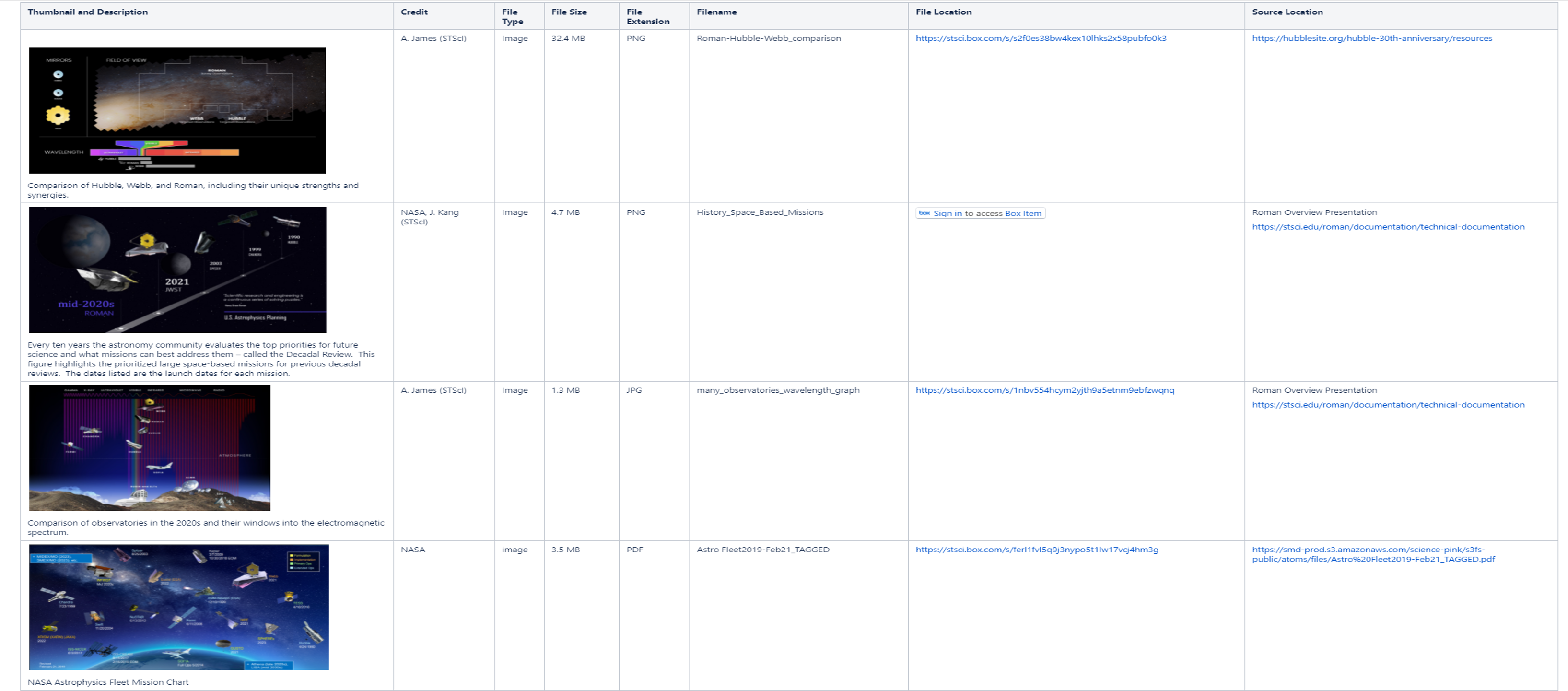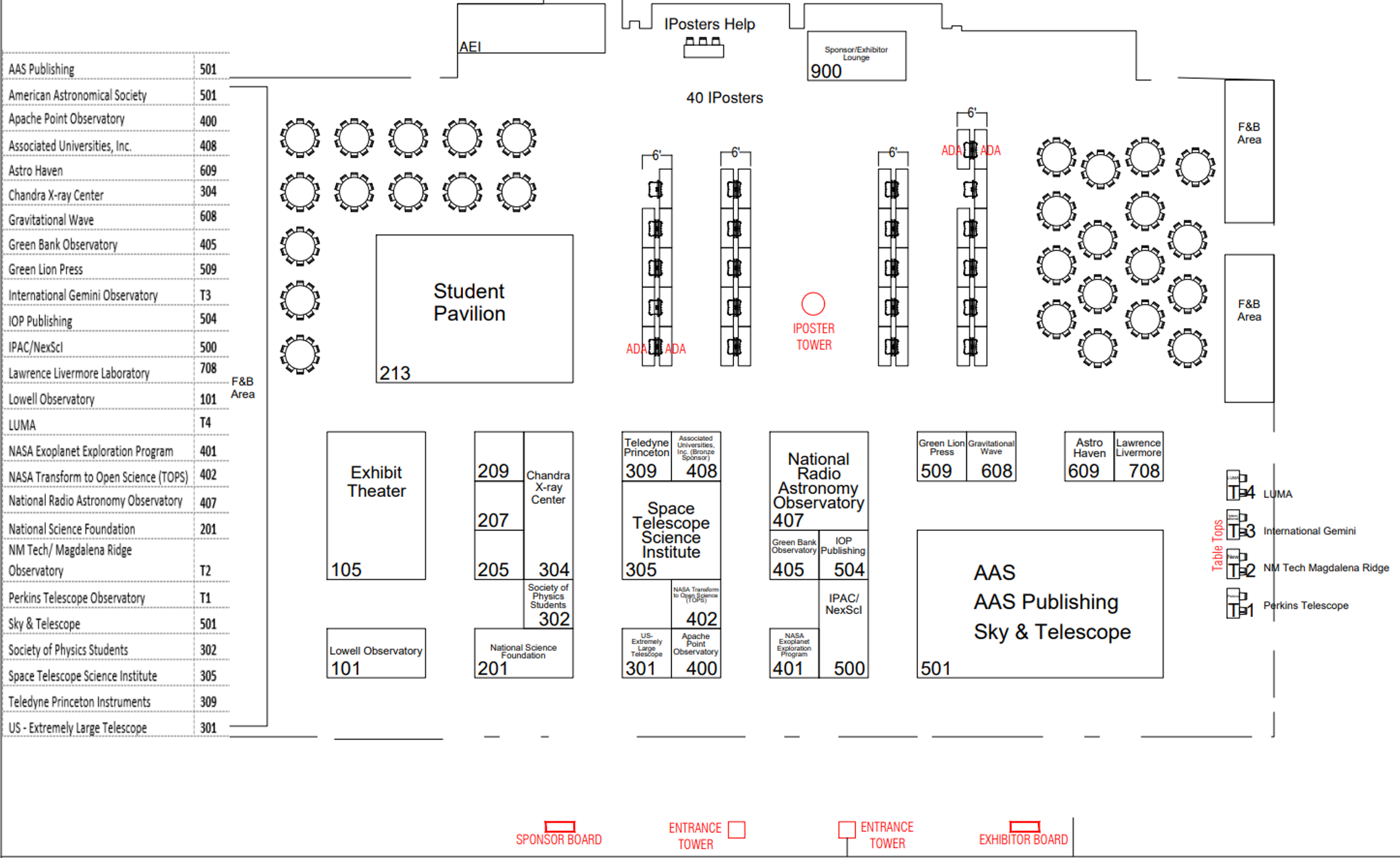Page History
| Content Layout Macro |
|---|
| Info | ||
|---|---|---|
| ||
If you are working on press-worthy science that relates to future Roman WFI science, we invite you to share your work with Brandon Lawton - lawton@stsci.edu - Project Scientist, Roman Science Communications. Brandon will be at the STScI booth and will work with the Roman partners to share your exciting science with the world! |
Roman Events at the |
243rd AAS Meeting | ||
| Location | Title | Date and Time ( |
|---|---|---|
| CT) | ||
|---|---|---|
Room: NASA Exhibitor Booth (Hall B-1/B-2) | NASA Hyperwall Presentation: Great [missions] are not maintained by timidity! | Sunday, January 7 7:30pm - 7:45pm |
Room: R07 | Splinter Meeting: | Monday, January 8 9:30am - 11:30am |
Room: Great Hall A | Town Hall: |
Monday, January 8 12: |
45pm - 1: |
Exhibit Hall 3
Exhibitor Theater
Big Data, Big Science: Overview of the Roman Space Telescope
(Tyler Desjardins)
Tuesday, June 6, 2023
2:00 PM - 2:30 PM
Exhibit Hall 3
iPoster 230.01
The Roman Space Telescope Science Operations Center: Wide Field Instrument Data Processing and Products
(Tyler Desjardins, Andrea Bellini, and Javier Sanchez)
Instrumentation for Space Missions session
Tuesday, June 6, 2023
5:30 PM - 6:30 PM
45pm | ||
Room: | iPoster: The Astronomer's Proposal Tool for the Roman Space Telescope (201.11) - WITHDRAWN, see flyer at the STScI booth | Tuesday, January 9 9:00am - 10:00am |
Room: NASA Exhibitor Booth (Hall B-1/B-2) | NASA Hyperwall Presentation: Coronagraph Technology Demo on the Roman Space Telescope | Tuesday, January 9 9:20am - 9:35am |
Room: 215 | Town Hall: | Tuesday, January 9 12:45pm - 1:45pm |
Room: 216 | Special Session: The Future of Galactic Plane Science with the Roman Space Telescope | Tuesday, January 9 2:00pm - 3:30pm |
Room: 240/241 | Splinter Meeting: | Tuesday, January 9 2:00pm - 3:30pm |
Room: R04 | Oral Presentation: The Roman Photometric Repeatability Floor (253.06) | Tuesday, January 9 3:20pm - 3:30pm |
Room: | iPoster: | Tuesday, January 9 5:30pm - 6:30pm |
Room: | iPoster: Automated Anomaly Detection at Scale With the Cloud-Based Roman Data Monitoring Tool (258.13) | Tuesday, January 9 5:30pm - 6:30pm |
Room: | iPoster: Simulating 3D Galaxy Datacubes for the Roman Space Telescope (258.28) | Tuesday, January 9 5:30pm - 6:30pm |
Room: 235/236 | Splinter Meeting: A Discussion of Science Drivers for Defining Roman's Core Community Surveys | Wednesday, January 10 9:00am - 11:30am
|
Room: NASA Exhibitor Booth (Hall B-1/B-2) | NASA Hyperwall Presentation: Obscured AGN with Roman– Hiding High Growth across Cosmic Time | Wednesday, January 10 9:05am - 9:20am |
Room: 210 | Oral Presentation: Cosmic ray detection for the Roman Wide Field Instrument (313.03) | Wednesday, January 10 10:20am - 10:30am |
Room: 209 | Oral Presentation: The Allure of 200,000 Transiting Exoplanets in the Roman Galactic Bulge Time Domain Survey (337.06) | Wednesday, January 10 3:20pm - 3:30pm |
Room: Hall B-1/B-2 | iPoster: The Roman Space Telescope Science Operations Center: News and updates (360.22) | Wednesday, January 10 5:30pm - 6:30pm |
Room: Hall B-1/B-2 | iPoster: |
Exhibit Hall 3
iPoster 230.02(Javier Sanchez et al.)
Instrumentation for Space Missions session
Wednesday, January 10 5:30pm - 6:30pm | ||
Room: Hall B-1/B-2 | iPoster: Prospects for Detecting Gaps in Globular Cluster Stellar Streams in External Galaxies with the Nancy Grace Roman Space Telescope (364.03) | Wednesday, January 10 5:30pm - 6:30pm |
Room: Hall B-1/B-2 | iPoster: Simulating Weak Gravitational Lensing in the Roman Space Telescope Using JWST Observed Galaxies (364.08) | Wednesday, January 10 5:30pm - 6:30pm |
Room: NASA Exhibitor Booth (Hall B-1/B-2) | NASA Hyperwall Presentation: The Dynamic Sky with NASA's Roman Space Telescope | Thursday, January 11 9:35am - 9:50am |
Room: NASA Exhibitor Booth (Hall B-1/B-2) | NASA Hyperwall Presentation: Roman Wide Field Instrument: From ground tests to science | Thursday, January 11 9:50am - 10:05am |
Room: 207 | Town Hall: | Thursday, January 11 12:45pm - 1:45pm |
Room: NASA Exhibitor Booth (Hall B-1/B-2) | NASA Hyperwall Presentation: Roman Science Operations Center Updates | Thursday, January 11 1:30pm - 1:45pm |
Room: Hall B-1/B-2 | iPoster: Non-Linearity Correction Methods for The Roman Space Telescope (457.08) | Thursday, January 11 1:30pm - 2:30pm |
Room: Hall B-1/B-2 | iPoster: Verification and Calibration of Spectroscopy and Polarization modes for the Roman Coronagraph Instrument (457.09) | Thursday, January 11 1:30pm - 2:30pm |
Room: Hall B-1/B-2 | iPoster: Spot-Based Measurement of the Brighter-Fatter Effect on a Roman Space Telescope H4RG Detector and Comparison with Flat-Field Data (457.26) | Thursday, January 11 1:30pm - 2:30pm |
Room: 212 | Oral Presentation: Population Survey and Image Simulation of Strong Gravitational Lenses Detectable by the Roman Space Telescope (439.05) | Thursday, January 11 2:50pm - 3:00pm |
Tuesday, June 6, 2023
5:30 PM - 6:30 PM
Exhibit Hall 3
iPoster 230.03
The Roman Space Telescope Science Operations Center: Simulation Tools
(Andrea Bellini et al.)
Instrumentation for Space Missions session
Tuesday, June 6, 2023
5:30 PM - 6:30 PM
Meeting Room 320
STScI Town Hall
Wednesday, June 7, 2023
12:45 PM - 1:45 PMRoman Resources | ||||||||||||||||||||||
Call for Community Input into the Definition of the Roman Space Telescope’s Core Community Surveys
The Nancy Grace Roman Space Telescope, NASA's next flagship observatory, is planned for launch in late 2026. The Roman Mission requests the astronomical community's input for the purpose of initiating the community-led definition of the Roman Space Telescope's Core Community Surveys. To maximize participation, this call for input consists.. Combined, these surveys are anticipated to use most of the observing time during Roman’s first five years. The cosmology and exoplanet science requirements for these surveys leave significant parameter space available to define the observational strategies (filters, depth, cadence, etc.) in a way that will enable a broad range of astrophysical investigations. This call for input consisted of two independent avenues for members of the community to provide information on science drivers and the requirements they place on the design of the Core Community Surveys . The second avenue, technically focused white papers describing what observing strategies are needed for a given science investigation, is now open. White papers are due by June 16, 2023. The first avenue, submission of a short, one to two paragraph 'science pitch' (including a questionnaire) was due February 17, 2023, and resulted in more than 100 submissions. Submission of a science pitch is not required for submission of a white paper.The second avenue, technically focused white papers describing what observing strategies are needed for a given science investigation were due by June 16, 2023. Over 70 submissions were received. All input is being All members of the community are encouraged to submit their science investigation ideas. The Roman Mission wants to hear from scientists worldwide across all career stages, positions, and types of institutions. All input will bepassed to the committees that will be formed of community members and tasked with defining the Core Community Surveys. We are now in the process of forming these committees. | ||||||||||||||||||||||
Welcome to the home for Roman Documentation (RDox)!Documentation for the Roman Space Telescope is currently under construction and subject to change, but represents the most up-to-date information available. |
| View file | ||||
|---|---|---|---|---|
|
Roman Community Forum
The Roman Space Telescope mission partners are planning to start the Roman Community Forum. This will be a monthly virtual meeting that will provide updates on Roman mission status and plans, and an opportunity for the science community to engage with the Roman Project and Science Centers.
Roman Virtual Lecture Series
The Nancy Grace Roman Space Telescope monthly virtual lecture series is run jointly by JPL, IPAC, Goddard, and STScI. These talks are open to the entire astronomy community and cover science, engineering, and technology related to the Roman mission. All are welcome and encouraged to attend. Talks are ~20 minutes with ~10 minutes for Q/A, and are scheduled for the 3rd Thursday of each month from 1-1:30 pm Pacific / 4-4:30 pm Eastern.
Roman Science and Technical Overview Brochure
| View file | ||||
|---|---|---|---|---|
|
You can also find the brochure here.
NASA Roman Coronagraph Instrument Fast Facts Sheet
| View file | ||||
|---|---|---|---|---|
|
Roman Virtual Backgrounds
Here are a series or Roman virtual backgrounds you can use in your virtual meetings and presentations.
| Expand | ||||||||||||||||||||
|---|---|---|---|---|---|---|---|---|---|---|---|---|---|---|---|---|---|---|---|---|
|
Roman Slide Set
| View file | ||||
|---|---|---|---|---|
|
This presentation highlights the science that will be enabled by the Nancy Grace Roman Space Telescope. The presentation includes notes for the presenter and can be used as a whole or in parts. It has been updated with accessibility in mind. The presentation comes in multiple formats, found here.
Roman Visual Library
The Roman Visual Library, located here, is a resource for astronomers to grab Roman-related images. You can find images, captions, credits, and image source locations here.
Roman Brochure
| View file | ||||
|---|---|---|---|---|
|
Targeted for launch in late 2026, the Nancy Grace Roman Space Telescope will revolutionize astronomy by building on the science discoveries and technological leaps of the Hubble and Webb space telescopes. The Roman brochure, located here, provides a simple way to express the power of Roman's field of view and is useful for all audiences.
Come and Find Us in the Exhibit Hall! |
How to Connect With Us |
|---|
NASA (Booth 702)
The Roman Space Telescope Project Office is at NASA's Goddard Space Flight Center, which also oversees the work on the Wide Field Instrument (WFI), the Spacecraft Bus, and System Integration.
At this booth, you can learn more about NASA’s Nancy Grace Roman mission as well as the mission’s Coronagraph Instrument. Roman's Coronagraph Instrument is being built by NASA JPL.
| Info | ||
|---|---|---|
| ||
Come by the NASA Town Hall, Tuesday, June 6, 12:45 PM - 1:45 PM in Ballroom C Monday January 8 (12:45p.m. CT), to hear the latest news about Roman and other NASA efforts from NASA officials. |
STScI (Booth
305614)
STScI is Roman’s Science Operations Center (SOC). The SOC is responsible for the mission's observation scheduling system, WFI data processing system for the direct-imaging mode and the mission's entire data archive. STScI performed pre-formulation, formulation, and design activities for Roman starting in 2014, and continues its role in science operations system engineering, design, science research support, and scientific community engagement and public outreach.
| Info | ||
|---|---|---|
| ||
The Roman Help Desk is operated joinly by the SOC and the SSC. Contact the SOC helpdesk for questions about SOC tools, WFI imaging, data calibration and archiving, proposal planning and scheduling. |
Caltech/IPAC (Booth
500615)
IPAC is home to the Roman Science Support Center. IPAC is responsible for Roman’s Coronagraph Instrument operations, high-level data processing of grism and prism data from the Wide Field Instrument (WFI), high-level data processing of WFI microlensing survey data and community engagement for Roman exoplanet science and wide field spectroscopy. IPAC will also implement the proposal solicitation and grant management for the General Observer, Guest Investigator and Theory programs, curate telescope instrument and simulation efforts and engage the greater scientific community in preparing for science with Roman.
| Info | ||
|---|---|---|
| ||
The Roman Help Desk is operated joinly by the SOC and the SSC. Contact the SSC helpdesk for questions about WFI spectroscopy, microlensing data processing, the proposal submission and review process, and the coronagraph. |
JPL is building Roman’s Coronograph Instrument and is involved with detector validation and developing the coronagraph’s science capabilities. The coronagraph will provide the first in-space demonstration of technologies needed for future missions to image and characterize rocky planets in the habitable zones of nearby stars. By demonstrating these tools in an integrated end-to-end system and enabling scientific observations, NASA will validate performance models and provide the pathway for potential future flagship missions.
Future Conference - Be Sure to Mark Your Calendars! |
|---|
Roman Science Inspired by Emerging JWST Results
Dates
June 20, 2023 - June 23, 2023
Location
Space Telescope Science Institute (STScI)
3700 San Martin Drive
Baltimore, MD 21218
Description
The Nancy Grace Roman Space Telescope, planned to launch in late 2026, will provide a simultaneous field of view 100 times larger than that of JWST, and sensitivity and resolution similar to that of HST. With incredible survey speeds, Roman will perform near-infrared imaging and spectroscopic surveys approximately 1000 times faster than the largest surveys on HST, yielding contiguously surveyed areas rivaling ground-based surveys. With these capabilities, the Roman surveys, both community-defined Core Community Surveys and competed General Astrophysics Surveys, will have broad impacts across all of astrophysics. Furthermore, Roman’s survey capabilities will be highly synergistic with JWST's ground-breaking sensitivity, extended wavelength coverage, and broad range of observing modes. Together, these observatories will operate in tandem not only with Hubble, but also with Rubin, Euclid, other ground-based and space-based facilities of the 2020s. The first year of science from JWST is already providing exciting scientific results on a wide range of topics that are relevant for Roman. We therefore announce a conference at the Space Telescope Science Institute (Baltimore, MD, USA) from June 19-23, 2023 that will focus on how emerging new results from JWST inform the planning for Roman’s surveys, including the science questions the surveys can address and their anticipated scientific yield. In concordance with the broad range of astrophysics addressed by both missions, we welcome contributions on all scientific topics connected to this theme, from solar system objects and exoplanets, to nearby galaxies, to the search for the first stars and galaxies, and everything in between. A writer's workshop will be offered concurrently with the conference.
How Roman Observations Will Confront Theory
https://conference.ipac.caltech.edu/roman2024/
Dates:
July 9 - 12, 2024
Location:
Caltech/IPAC campus
Description:
The goal of this 4-day conference is to bring together inclusively members of the community to discuss how observations with the Nancy Grace Roman Space Telescope will confront and challenge theories, from exoplanets to the edge of the Universe. The conference will focus mainly on the Core Community Surveys -- the Galactic Bulge Time Domain Survey, High Latitude Wide Area Survey, and High Latitude Time Domain Survey, which will occupy the majority of the primary mission -- as well as the Coronagraph Instrument technology demonstration. However, there are boundless theories that will also be addressed and tested by the wide variety of General Astrophysics Surveys. This conference, to take place on the Caltech campus and online, will be an active and exciting confluence of both observers and theorists to outline the potential breakthroughs that could be made possible during the lifetime of the Roman Space Telescope.
If you have any questions, you can email us at romanssc@ipac.caltech.edu .
| title | June 9 - Virtual Registration Closes |
|---|
Register and find out more information here:
https://www.stsci.edu/contents/events/stsci/2023/june/roman-science-inspired-by-emerging-jwst-results| Content Layout Macro |
|---|

